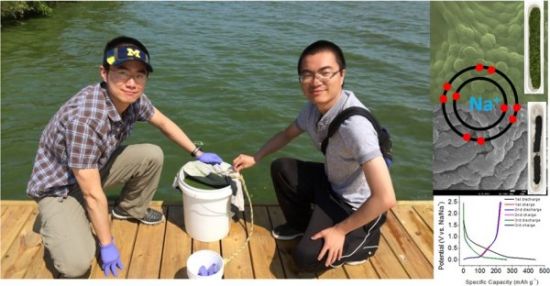 |
Algae were collected on August 9th, 2014 at the site of algal blooms at Lake Erie (GPS: 41°42′16.1′′N, 83°28′30.0′′W). The inset shows dried algal bloom before and after heat treatment. Credit: Da Deng, Wayne State University
Last August, the seasonal outbreak of seasonal harmful algae in Lake Erie became so extreme that the water system in Toledo, Ohio became toxic, leaving 500,000 residents with no water to drink. However, some researchers collected some toxic algal blooms at that time and have proved that by heating them to temperatures of 700-1000°C in argon, they can be transformed into so-called "hard carbon" materials that can be used as large Capacity Low-cost electrode materials for sodium ion batteries.
The researchers led by Dr. Deng Da, an environmental engineer at Wayne State University in Detroit, published a paper on the use of algal blooms as an electrochemical energy storage in a recent issue of Environmental Science and Technology.
“The outbreak of harmful algae caused by cyanobacteria seriously threatens humans, livestock, and wildlife, causing illness and even death,†Deng said. “The Toledo water crisis caused by algal blooms in 2014 was a vivid example of its destruction. The algal bloom reduction technology is passive and has certain limitations. If alternative technologies can transform algal blooms into high value-added functional products, it will significantly impact our society and the environment.â€
Deng explained that such a high-value product may be the electrode of a sodium-ion battery and has the potential to replace the main application of lithium-ion batteries.
"We demonstrated the conversion of freshly collected algal blooms from Lake Erie, near Toledo, to high-performance electrodes for sodium-ion batteries," he said. "We call it a "waste-to-treat" approach. This technology is expected to ease algae. Hua, overcomes its environmental threat and provides 'green' electrodes for reversible sodium storage in sodium-ion batteries."
As Deng explained, sodium-ion battery technology is still in its infancy compared to lithium-ion batteries. One of the challenges of developing sodium-ion batteries is to find a reliable electrode material. Although graphite is often used for lithium ion battery electrodes, larger sodium ions are not as good as graphite structures for smaller lithium ions. In contrast, sodium ions are more suitable for hard carbon, it is more disordered than graphite, and contains a larger number of large defects and voids, which can store larger sodium ions.

August 9, 2014 Dr. Deng’s laboratory at Wayne State University collected algal blooms in Lake Erie. Credit: Da Deng, Wayne State University
Although hard carbon is most often derived from petroleum, it can also be made from biomass. This study was the first direct conversion of algal blooms (especially blue-green algae) to carbon for sodium-ion batteries. Algal blooms have the advantage of rapid growth and do not require land or soil. Moreover, the researchers found that algal blooms can be easily converted to hard carbon by simple heat treatment without purification or other additional processes.
After the algae was heated, the researchers fabricated electrodes using a mixture of 80% hard carbon from algae, 10% carbon black (used to increase conductivity) and 10% binder. After this slurry was dried overnight, they assembled the button cells together using nano foil as the counter electrode. Tests have shown that the electrode initially has a capacity of up to 440 mAh/g, but after irreversible capacity loss after the first cycle, the capacity drops to about 230 mAh/g. From the second cycle, the electrode has good capacity retention. . Researchers also found that some performance factors, including capacity and stability, depend on the temperature at which the algae is heated, which indicates a way to improve their performance in the future.
“Our future research will focus on optimizing the electrochemical performance of Algae-derived carbon-sodium-ion batteries,†Deng said. “We will try to solve the first cycle of irreversible capacity loss of sodium-ion batteries. We are also developing large-scale harvesting algae. China's approach and study their impact on the ecosystem."
Overall, the researchers explained that this “waste-to-treat†conversion process is one stone and two birds: relieving the problem of algal blooms in freshwater lakes and providing useful sodium-ion battery electrode materials, which have huge potential relative to lithium-ion batteries. Cost advantage. To illustrate, the researchers pointed out that the cost of lithium-ion batteries in 2014 was about 410 dollars per kilowatt-hour, while the average retail price of electricity in the United States was about 10 cents per kilowatt-hour. Because sodium is much richer than lithium, it is expected that sodium-ion batteries will greatly reduce this cost in the future. (Author: Wang lost pocket)
Winch Rope,Nylon Winch Rope,Synthetic Winch Rope,Tow Winch Rope
Baoying Yiliyuan Rope And Net Co.,Ltd , https://www.ylyropes.com